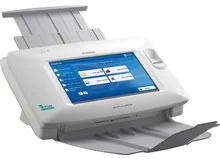3 Tips for Choosing a Network Document Scanner
Network Document Scanners are a popular choice for companies getting started with document scanning, and with good reason. They’re reasonably priced, don’t require a dedicated computer, and help companies quickly convert Paper to Digital Images. When looking for a scanner though, it’s easy to be overwhelmed by all of the choices – are you sure you know what DPI is best for your application? When you go to make a purchase decision, consider these factors:

1) Daily Scanning Volume – This is the most important consideration when buying any scanner, networked or otherwise. Think about how many pages you’ll need to capture on a daily basis, and make your buying decision accordingly. Try not to consider your entire backfile scanning project when making this determination, either – just think about how many pages you’re likely to capture on a daily basis during the normal course of business. You can always outsource to a document scanning service provider to address your bulk scanning issues, saving you time and money in the process.
2) Bundled Software – Without Software, a scanner is just an expensive paperweight. You should make sure that some level of document scanning software is included with the equipment. It’s particularly helpful if this is a flexible software toolkit like eCopy or NSi Autostore. These packages will let you do more than just drop images on network share devices and help you drive more value out of your investment.
3) Touchscreen or Keyboard Capabilities – Once you scan an image, you’re going to want to be able to tag it with some sort of meaningful data to let you find it, or at least let the person on the other end of the receipt have an idea what it is. Be sure that the device you choose has a Touchscreen interface at the least, and ideally offers the option of attaching a keyboard. Some models, like the HP and Fujitsu Network Scanners, even come with built in keyboards, making them an attractive alternative for companies that need to add a bit more detail to what they’re scanning.
There are a lot of options available when looking to buy a scanner, and it’s important to not be distracted by the bright and shiny features. Most of the time, they’re not going to be of much use to you. Instead, keep these practical elements in mind when making your buying decision and you’ll end up much happier with the results.
